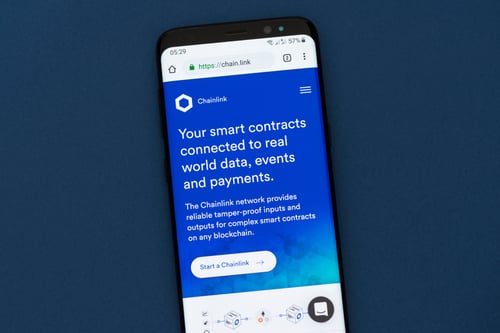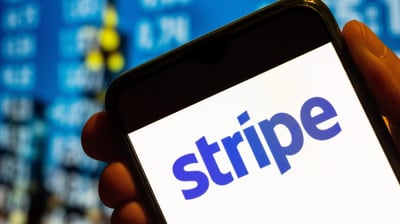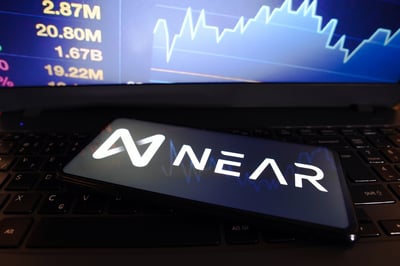Backed has announced the integration of Chainlink Proof of Reserve (PoR) on its platform. In a press release shared with Cryptowisser, the team said this latest development provides users with a transparent and trust-minimized means to confirm the collateralization of Backed’s tokenized assets.
The integration of Chainlink PoR is a significant step forward in how Backed users can gain assurance that their assets are appropriately collateralized. PoR introduces a way for users to independently verify the adequacy of collateral reserves on-chain at any time. This is crucial for maintaining the integrity of tokenized assets.
How Backed’s Proof of Reserves Solution Works
When a user purchases bTokens, Backed automatically purchases the underlying asset as collateral once they receive the funds. Backed then proceeds to send an order to buy the underlying asset to their broker. The team then issue the tokens to the user. In most cases, this whole process takes minutes - and Backed strives to make it even more efficient.
The Network Firm operates its auditing API. The firm has read-only access to Backed’s custody bank accounts and can constantly read their account balances. They update the API data every 10 minutes.
Furthermore, securities in transit are taken into account as a separate data point. This is because it takes a few days for securities to settle in our bank account. The Network Firm reads internal transaction data from Backed, which guarantees the underlying assets are in transit to our Swiss custodian.
The combined data is then verified by Chainlink Proof of Reserve’s decentralized oracle network. The figures relayed by Chainlink PoR are updated daily, or if the volume of the reserves changes by more than 10%.
The data becomes part of Backed’s proof of reserves solution for its popular products. The amount of collateral Backed has purchased and held is publicly displayed on their website and available on-chain.
While commenting on this latest development, Adam Levi, Backed Co-founder, said,
“When we first set up Backed, we knew how important it would be to have verifiable, on-chain, transparent data that proved our assets were fully collateralized. Integrating Chainlink Proof of Reserve is a major milestone in achieving the company’s goal of creating products that are verifiably backed 1:1 and fully composable.”
Why Is Proof Of Reserves Important?
Backed’s PoR solution is important because the team wants to be trusted through transparency, providing independently verified data that is consistently updated and available on-chain. By providing this data, users can be confident that the amount of bTokens will be equal to the amount of the underlying asset held.
The team said Backed has already undergone regular audits as required by Swiss regulations. This new development makes the data public and increases the frequency of data points dramatically. By bringing the data on-chain, the usability increases, meaning that third parties using Backed products can develop their own mechanisms to demonstrate the legitimacy of their operations.
How Does Chainlink Proof of Reserve (PoR) Work?
Chainlink PoR provides smart contracts with the data required to calculate the true collateralization of any on-chain asset backed by off-chain reserves. It is operated by a decentralized network of oracles and enables the autonomous verification of collateral in real-time, helping ensure user funds are protected from unforeseen fractional reserve practices or fraudulent activity.
Chainlink PoR is deployed to enable automated on-chain verification that gives users a superior guarantee of an asset’s underlying collateralization and generates a higher degree of transparency around asset collateralization.
Why Tracking In Transit Securities Is Important
A crucial part of Backed’s integration is tracking traditional financial assets before they have settled in the Backed custodian's accounts. Traditional financial assets may be in transit for two to three days. Bridging traditional finance onto crypto rails comes with problems that require unique solutions.
Backed pointed out that they provide an API that makes their internal transaction data available to The Network Firm and, in turn, Chainlink, creating a stronger guarantee that Backed’s tokens are collateralized even while the underlying assets are in transit to the Backed custodian from their broker. This means users can be confident their bTokens are always 1:1 backed.
Chainlink is the industry-standard decentralized computing platform powering the verifiable web. Chainlink has enabled over $8.5 trillion in transaction value by providing financial institutions, startups, and developers worldwide with access to real-world data, offchain computation, and secure cross-chain interoperability across any blockchain.
Backed bridges real-world assets on-chain. Backed issues on-chain tokens that track the value of real-world assets, such as stocks or ETFs. Tokens are freely transferable across wallets, are fully collateralized by the underlying asset, and are issued in compliance with the Swiss DLT Act.
 Hassan Maishera
Hassan Maishera





